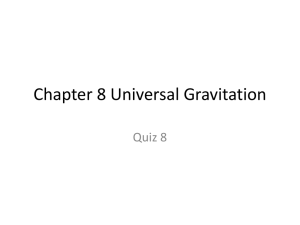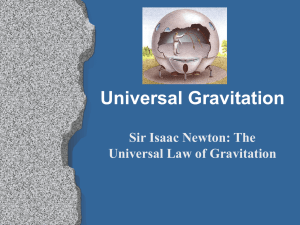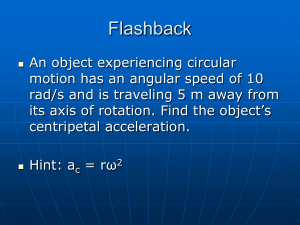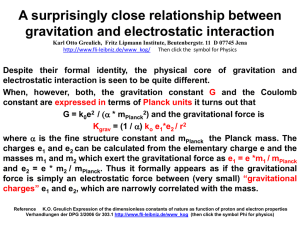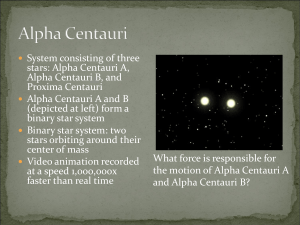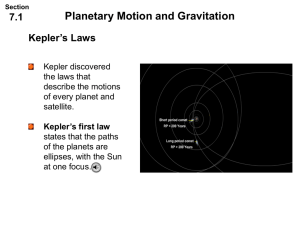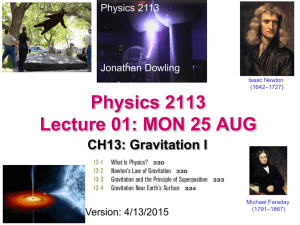Gravitation PowerPoint
advertisement
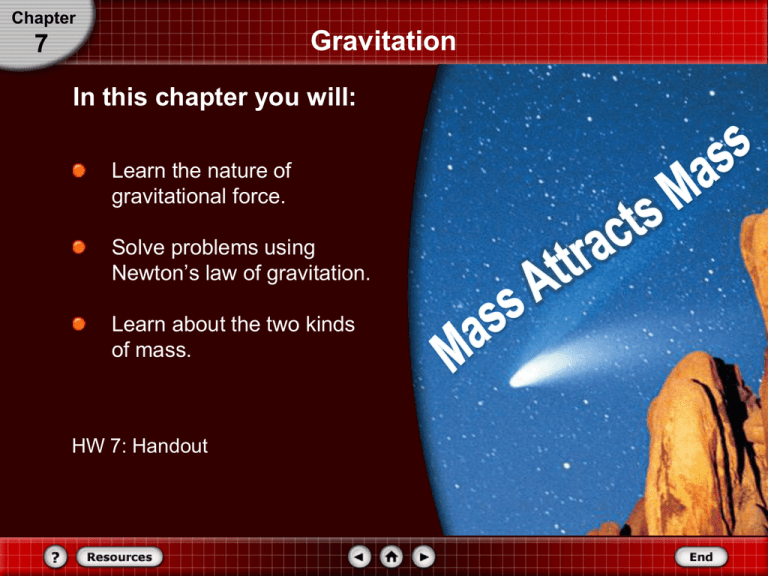
Chapter Gravitation 7 In this chapter you will: Learn the nature of gravitational force. Solve problems using Newton’s law of gravitation. Learn about the two kinds of mass. HW 7: Handout Section 7.1 Planetary Motion and Gravitation Newton’s Law of Universal Gravitation In 1666, Sir Isaac Newton began his studies of planetary motion. Newton found that the magnitude of the force, F, on a planet due to the Sun varies inversely with the square of the distance, r, between the centers of the planet and the Sun. That is, F is proportional to 1/r2. The force, F, acts in the direction of the line connecting the centers of the two objects. Section 7.1 Planetary Motion and Gravitation Newton’s Law of Universal Gravitation The sight of a falling apple made Newton wonder if the force that caused the apple to fall might extend to the Moon, or even beyond. He found that both the apple’s and the Moon’s accelerations agreed with the 1/r2 relationship. Section 7.1 Planetary Motion and Gravitation Newton’s Law of Universal Gravitation According to his own third law, the force Earth exerts on the apple is exactly the same as the force the apple exerts on Earth. The force of attraction between two objects must be proportional to the objects’ masses, and is known as the gravitational force. Section 7.1 Planetary Motion and Gravitation Newton’s Law of Universal Gravitation The law of universal gravitation states that objects attract other objects with a force that is proportional to the product of their masses and inversely proportional to the square of the distance between them. The gravitational force is equal to the universal gravitational constant, times the mass of object 1, times the mass of object 2, divided by the square of the distance between the centers of the objects. Section Planetary Motion and Gravitation Newton’s Law of Universal Gravitation Force Vs. Mass According to Newton’s equation, F is directly proportional to m1 and m2. 1 0.9 0.8 0.7 0.6 F m1m2 Force (N) 7.1 0.5 0.4 0.3 0.2 0.1 0 0 1 2 3 Mass (kg) 4 5 Section 7.1 Planetary Motion and Gravitation Inverse Square Law According to Newton’s equation, F is inversely related to the square of the distance. Section 7.1 Planetary Motion and Gravitation Universal Gravitation Newton’s law of universal gravitation has both direct and inverse relationships. F m1m2 F 1/r2 Change Result Change Result 2m1m2 2F 2r 1/4 F 3m1m2 3F 3r 1/9 F 4m1m2 4F 1/2 r 4F ½m1m2 1/2 F 1/3 r 9F Section 7.1 Gravitation Measuring the Universal Gravitational Constant How large is the constant, G? The force of gravitational attraction between two objects on Earth is relatively small. In fact, it took 100 years from the time of Newton’s work for scientists to develop an apparatus that was sensitive enough to measure the force kg2of gravitational attraction. G = 6.67 x -11 10 2 Nm 2 kg Section 7.1 Planetary Motion and Gravitation Measuring the Universal Gravitational Constant Video clip: Ch7_4_movanim Section 7.1 Planetary Motion and Gravitation Importance of G Cavendish’s experiment often is called “weighing Earth,” because his experiment helped determine Earth’s mass. Once the value of G is known, not only the mass of Earth, but also the mass of the Sun can be determined. In addition, the gravitational force between any two objects can be calculated using Newton’s law of universal gravitation. Section 7.1 Planetary Motion and Gravitation Example: The attractive gravitational force, Fg, between two bowling balls of mass 7.26 kg, with their centers separated by 0.30 m, can be calculated as follows: Section Gravitation 7.1 Practice Problems 1. What is the gravitational force between two 15 kg packages that are 35 cm apart? 2. The gravitational force between two electrons that are 1.00 m apart is 5.54 x 10-71 N. Find the mass of the electron. 3. The Moon’s mass is 7.34 x 1022 kg, and it is 3.8 x 105 km away from Earth. Earth’s mass is 5.97 x 1024 kg. Calculate the gravitational force of attraction between Earth and the Moon. Section 7.1 Planetary Motion and Gravitation Cavendish’s Experiment Determined the value of G. Confirmed Newton’s prediction that a gravitational force exists between two objects. Helped calculate the mass of Earth. Section 7.2 Using the Law of Universal Gravitation Two Kinds of Mass Mass is equal to the ratio of the net force exerted on an object to its acceleration. Mass related to the inertia of an object is called inertial mass. Inertial mass is equal to the net force exerted on the object divided by the acceleration of the object. Section 7.2 Using the Law of Universal Gravitation Two Kinds of Mass The inertial mass of an object is measured by exerting a force on the object and measuring the object’s acceleration using an inertial balance. The more inertial mass an object has, the less it is affected by any force – the less acceleration it undergoes. Thus, the inertial mass of an object is a measure of the object’s resistance to any type of force. Section 7.2 Using the Law of Universal Gravitation Two Kinds of Mass Mass as used in the law of universal gravitation determines the size of the gravitational force between two objects and is called gravitational mass. The gravitational mass of an object is equal to the distance between the objects squared, times the gravitational force, divided by the product of the universal gravitational constant, times the mass of the other object. Section 7.2 Using the Law of Universal Gravitation Two Kinds of Mass ch7_6_mov.anim (no audio) Section 7.2 Using the Law of Universal Gravitation Two Kinds of Mass Newton made the claim that inertial mass and gravitational mass are equal in magnitude. This hypothesis is called the principle of equivalence. All experiments conducted so far have yielded data that support this principle. Albert Einstein also was intrigued by the principle of equivalence and made it a central point in his theory of gravity. Section Section Check 7.1 Question 1 According to the law of universal gravitation, how are force and distance related? A. The gravitational force is inversely proportional to mass. B. The change in gravitational force with distance follows the inverse square law. C. Gravitational force and distance are directly proportional. D. Gravitational force does not depend on distance. Section Section Check 7.1 Answer 1 Answer: B Reason: F = G m1m2 r2 Section Section Check 7.1 Question 2 If the Earth suddenly lost half of its mass, what would happen to the gravitational force between it and the moon? A. The gravitational force would remain the same. B. The gravitational force would double. C. The gravitational force would be cut in half. D. The gravitational force would be four times smaller. Section Section Check 7.1 Answer 2 Answer: c Reason: F = G m1m2 r2 Section Section Check 7.1 Question 3 Which of the following helped calculate Earth’s mass? A. Inverse square law B. Cavendish’s experiment C. Kepler’s first law D. Kepler’s third law Section Section Check 7.1 Answer 3 Answer: B Reason: Cavendish's experiment helped calculate the mass of Earth. It also determined the value of G and confirmed Newton’s prediction that a gravitational force exists between two objects. Section Section Check 7.2 Question 4 The inertial mass of an object is measured by exerting a force on the object and measuring the object’s __________ using an inertial balance. A. gravitational force B. acceleration C. mass D. force Section Section Check 7.2 Answer 4 Answer: B Reason: The inertial mass of an object is measured by exerting a force on the object and measuring the object’s acceleration using an inertial balance. Section Section Check 7.2 Question 5 Your weight __________ as you move away from Earth’s center. A. decreases B. increases C. becomes zero D. does not change Section Section Check 7.2 Answer 5 Answer: A Reason: As you move farther from Earth’s center, the acceleration due to gravity reduces, hence decreasing your weight. Circular Motion and Gravitation Test Information The test is worth 41 points. True/False – 5 questions, 1 point each Multiple Choice – 3 questions, 1 point each Short Answer – 4 questions, 2 points each Problems – 3 questions with multiple parts, total of 25 points

